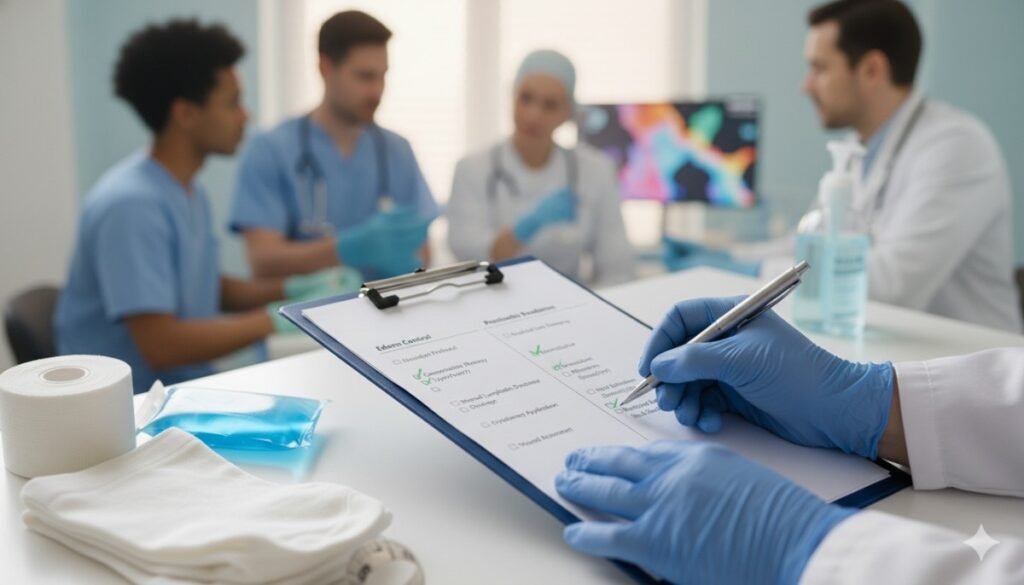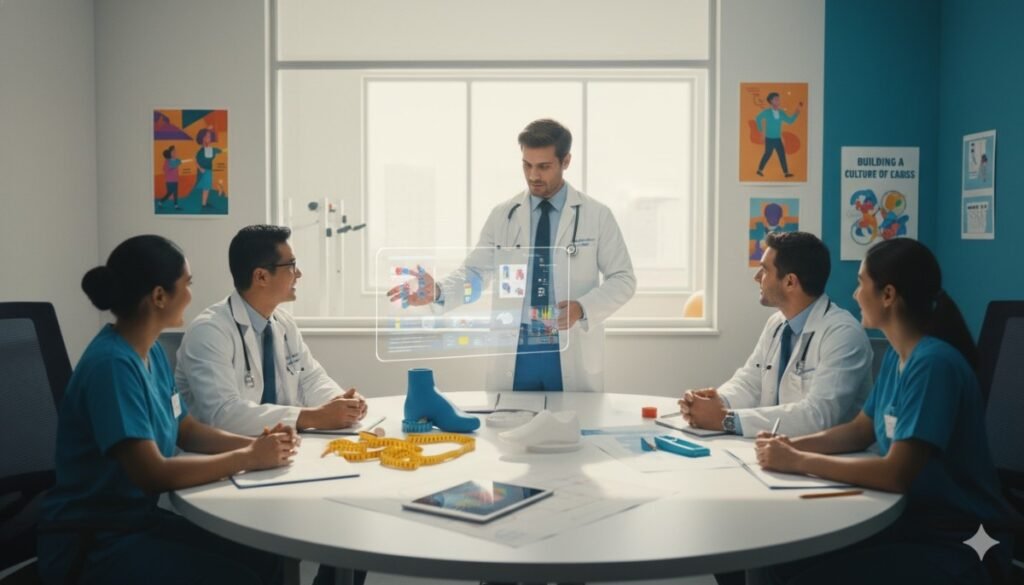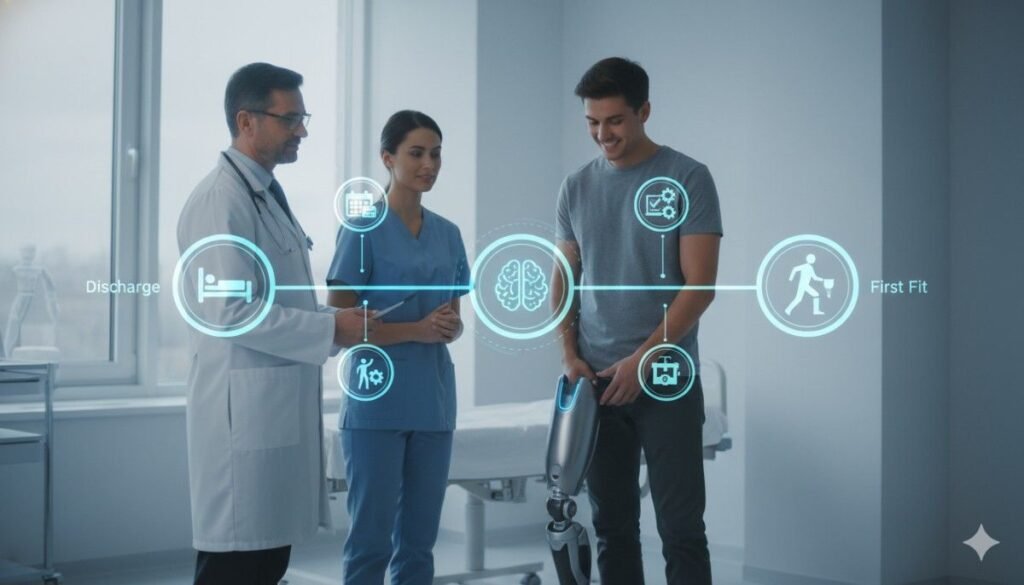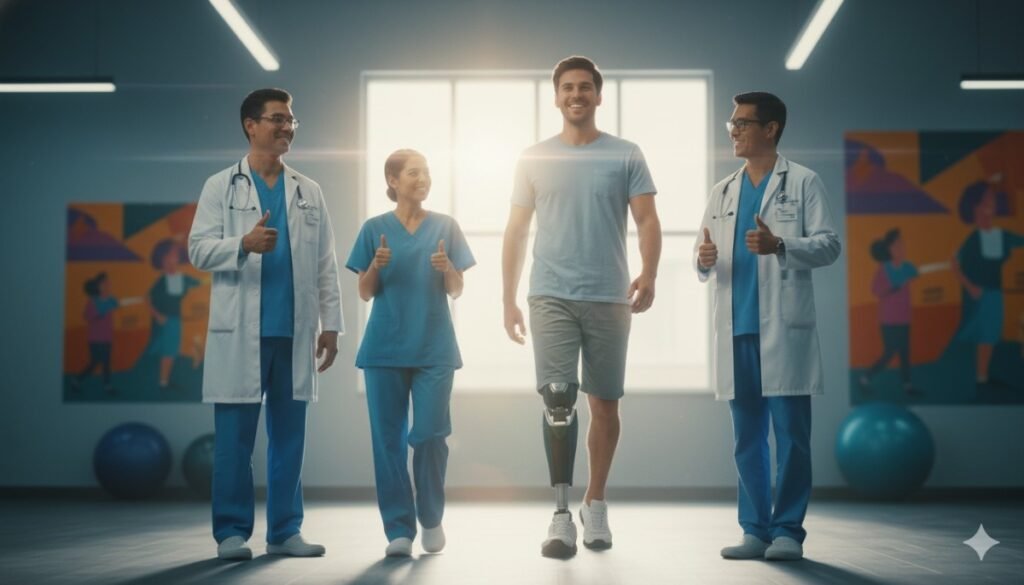The first few weeks after a patient receives a prosthetic limb are filled with questions. How is the skin responding? Are the muscles strong enough? Is the socket fit stable? Most importantly, is the patient emotionally coping with this new stage of life?
For doctors, the early-fit period isn’t just about mechanical success — it’s about holistic adaptation. That’s why early-fit reviews, guided by a multidisciplinary team (MDT), are so important. These collaborative meetings bring together prosthetists, physiotherapists, occupational therapists, psychologists, and rehabilitation specialists to evaluate how the patient is truly doing — not just on paper, but in practice.
When done well, these reviews prevent complications before they start. They identify red flags, adjust care plans, and strengthen patient confidence. But when rushed or uncoordinated, they risk overlooking subtle issues that could later become serious setbacks.
The challenge for doctors is not in attending the meeting — it’s in running it effectively. A well-run early-fit MDT review is structured yet flexible, scientific yet empathetic. It allows every voice to be heard while keeping the discussion focused on one goal: safe, steady, sustainable recovery.
This article is a detailed blueprint on how doctors can lead early-fit MDT case conferences that truly work. You’ll learn how to set clear agendas, manage team dynamics, interpret data meaningfully, and ensure every review translates into real patient progress.
Let’s begin by understanding what an early-fit MDT review really is — and why it’s the cornerstone of modern prosthetic care.
Understanding Early-Fit MDT Reviews
What an Early-Fit MDT Review Means

An early-fit MDT review is a structured meeting held soon after a patient receives their first prosthetic limb. It allows every professional involved in the rehabilitation process to come together and evaluate progress.
The goal isn’t just to check the prosthetic fit, but to understand the patient’s overall adaptation — physical, emotional, and social. This holistic view helps the team identify early challenges and correct them before they grow into major issues.
Each discipline brings its own insight. The doctor monitors medical stability, the prosthetist checks mechanical comfort, the physiotherapist observes movement patterns, and the psychologist assesses emotional readiness. Together, they form a complete picture of the patient’s recovery.
The Timing of the First Review
Timing plays a key role in early-fit reviews. The first MDT conference is usually held within two to three weeks after initial prosthetic fitting. By this time, the patient has started limited wear and basic exercises.
This window allows professionals to see how the limb and body are interacting. The skin’s response, muscle strength, and patient confidence become visible markers of progress.
Waiting too long may allow small complications to go unnoticed. Holding it too early, however, can make observations less accurate because the limb is still adjusting. The two-week mark often strikes the right balance.
The Doctor’s Role in Leading the Review
Doctors are the natural anchors of MDT meetings. They set the clinical tone, define priorities, and ensure that discussions remain centered on patient safety.
A good chairing doctor listens carefully, encourages input from every discipline, and turns observations into actionable plans. They translate what’s discussed in the meeting into clear next steps for the patient’s care schedule.
Being both the medical decision-maker and the facilitator requires balance — leadership with empathy. The best reviews feel structured but never rushed.
Why the MDT Format Works
The multidisciplinary format brings diverse expertise to a single table. No single clinician can see every angle of prosthetic adaptation. The MDT model bridges that gap.
For example, a physiotherapist might notice that a patient avoids weight-bearing on one side. The prosthetist might then check if socket pressure is uneven. The psychologist could add that anxiety may be affecting posture.
This cross-sharing creates a 360-degree view of the problem — and leads to solutions that are both medically sound and personally suitable for the patient.
Why Team Collaboration Matters in the First 90 Days
The Window of Adaptation
The first 90 days after prosthetic fitting define how the body and mind will adapt long-term. Muscles are re-learning balance, the skin is hardening to pressure, and the brain is building new pathways for control.
During this time, even small issues — like swelling, socket misfit, or emotional distress — can set back progress if not addressed early. That’s why the early-fit MDT is crucial. It keeps the team aligned during this fragile stage.
The goal is early correction, not late reaction. Preventive care works best when multiple eyes are watching from different angles.
Reducing Overload for Patients
A new prosthesis brings excitement but also physical and emotional strain. Patients must learn new skills while managing pain, fatigue, and uncertainty.
By working as a team, doctors can share this load. The physiotherapist can monitor endurance, the psychologist can manage emotional fatigue, and the prosthetist can fine-tune the fit.
This shared care approach prevents overload — not just for the patient, but for the doctor as well. Each professional supports the other’s expertise.
Establishing Clear Communication Channels
Collaboration only works when communication is smooth. During the first 90 days, updates must flow continuously between professionals.
Doctors can set simple systems: a shared case log, short weekly summaries, or quick group calls. These small habits prevent confusion and ensure that everyone knows what’s happening between reviews.
The clearer the communication, the fewer surprises arise during meetings.
Aligning Medical and Functional Goals
Doctors often focus on medical healing, while therapists focus on movement and prosthetists on fit. Without coordination, these goals can conflict.
For instance, a physiotherapist might encourage longer wear time, while the doctor prefers rest to reduce swelling. The MDT meeting aligns these perspectives, ensuring one consistent plan for the patient.
This unity avoids mixed signals and strengthens the patient’s confidence in the care team.
The Emotional Advantage of Team Support
Patients draw strength not only from their prosthesis but from the people guiding them. When they see a united team working together, it creates trust and reassurance.
Each discipline reinforces the other. When a patient’s physiotherapist praises their balance, and the doctor confirms improved healing, it creates a powerful emotional boost.
That sense of collective support often determines whether a patient stays motivated during recovery’s toughest moments.
Preparing for a Successful Case Conference
Defining the Objective

Every MDT review must begin with a clear purpose. Is this session about initial fit verification, pain management, emotional adjustment, or gait training progress?
Defining the main focus helps the team stay on track. Without a clear objective, discussions can drift, and important details may be missed.
Doctors can begin each meeting with a simple statement of intent — one sentence that sets direction for everyone.
Gathering Data Beforehand
Preparation makes or breaks a good conference. Each team member should arrive with their observations documented in advance.
The prosthetist provides socket fit feedback and liner wear notes. The physiotherapist shares gait and endurance updates. The occupational therapist records daily task performance.
The doctor’s role is to synthesize these inputs into a coherent clinical summary. This preparation allows the meeting to focus on solutions rather than catching up on information.
Patient Participation in the Review
Whenever possible, patients should be part of the early-fit discussion — at least for part of the session. Their voice gives context to the data.
Hearing how the prosthesis feels, when discomfort occurs, or what emotions they experience during use adds depth to clinical observations.
For many patients, simply being heard helps reduce anxiety. Their inclusion also improves cooperation with follow-up instructions.
Setting the Right Environment
The tone of the meeting matters as much as the content. An early-fit review should feel calm, welcoming, and focused.
Doctors can set this tone by choosing a quiet room, maintaining eye contact, and encouraging open dialogue. Avoid medical jargon; use clear, simple language.
A relaxed environment helps both the patient and professionals speak freely — leading to more honest, useful discussion.
Coordinating Time and Structure
A productive MDT review respects time. Doctors can structure the session into clear sections: patient summary, professional feedback, discussion, and action plan.
Each section can be timed loosely — not rigidly, but with awareness. This balance keeps the session efficient without feeling rushed.
Time management also shows respect for each team member’s schedule and the patient’s energy level.
Conducting the Meeting Effectively
Opening with a Clear Summary
Every meeting should start with a concise case summary. The doctor introduces the patient’s background, current status, and the main purpose of the review.
This aligns everyone instantly. Even if a team member missed earlier updates, they can quickly catch up and contribute meaningfully.
A clear start also signals that the meeting is structured, not improvisational.
Encouraging Equal Participation
In effective MDTs, no voice dominates the room. The doctor leads, but listens actively. Every specialist — from the physiotherapist to the prosthetist — offers observations based on their unique perspective.
Encouraging participation prevents tunnel vision. Sometimes, a small comment from one member uncovers the key insight that changes the entire plan.
Balancing Data and Dialogue
Numbers are valuable — limb measurements, wear times, pain ratings — but stories matter too. The best reviews blend both.
Doctors can guide the team to discuss what the data means in practice. For example, if a patient wears the prosthesis for six hours daily but reports fatigue, the data and experience together reveal the real picture.
This balance makes the review both scientific and human.
Managing Disagreements Professionally
Differences in opinion are normal. A therapist may recommend more activity, while the doctor prefers caution. The doctor’s role is to mediate calmly and seek consensus based on patient safety.
Clear reasoning, supported by evidence or experience, often resolves disagreements quickly. The focus must remain on what benefits the patient most — not on who is “right.”
Turning Discussion into Action
The most common failure in MDT meetings is ending with no clear outcome. Doctors must close each session with a documented action plan — what will be done, who will do it, and by when.
A simple, written summary shared with the team prevents confusion later. It also gives the patient clarity about their next steps.
Evaluating Outcomes After the Review
Translating Decisions into Real Progress

A good case conference doesn’t end with discussion — it ends with direction. The actions decided in the meeting must translate into real-world improvements. That means ensuring every team member knows their specific next step.
Doctors often take the lead in assigning follow-up responsibilities. For example, if socket fit adjustments are needed, the prosthetist is given a clear deadline. If emotional distress is observed, the psychologist sets up individual sessions. Every task should be measurable and time-bound.
Clarity turns meetings from talk into transformation.
Creating a Feedback Loop
Once decisions are made, the next challenge is to track their effect. Doctors should encourage all team members to provide quick feedback within a few days of implementation.
Short progress notes shared over email or a secure digital log help the team see what’s working and what isn’t. This loop ensures that adjustments remain active, not forgotten until the next meeting.
When feedback is consistent, the patient experiences smoother, faster improvement.
Measuring Physical and Emotional Changes
Doctors must evaluate both tangible and intangible results. On the physical side, measurements like wear duration, pain reduction, or gait stability help gauge success.
But emotional progress — such as confidence during therapy, improved sleep, or reduced frustration — matters just as much. These can be captured through short interviews or observation during therapy sessions.
Quantitative and qualitative tracking together provide a full picture of healing.
Reviewing the Effectiveness of Adjustments
After implementing changes, doctors revisit the results during follow-up meetings. If socket comfort improves and skin irritation reduces, the team knows the adjustment worked. If pain persists, it’s time to refine the plan.
This reflective process is what keeps MDT reviews dynamic. Each meeting builds on the last, creating a steady curve of progress rather than a flat line of routine.
Reflection makes every next meeting smarter than the one before it.
Celebrating Small Wins
Acknowledging progress — even tiny steps — strengthens morale. Doctors can take a moment to appreciate improvements noticed by therapists or reported by patients.
Simple recognition makes a big difference. When patients feel their efforts are valued, they stay motivated. When team members see their input driving change, collaboration deepens.
Gratitude turns a review into a celebration of shared success.
Follow-Up Strategies
Scheduling the Next Review
At the end of each MDT session, the doctor should set a date for the next review. This timeline depends on how active the current issues are. Some cases need review after a week, others after a month.
The schedule should be flexible enough to adapt to patient progress. A well-timed review prevents small problems from returning unnoticed.
Mid-Session Check-Ins
Between conferences, doctors can request short updates. These check-ins may be brief phone calls, quick video consultations, or written notes shared digitally.
They help identify red flags early without the need for a full meeting. If something feels off, the doctor can call for an interim session rather than waiting for the scheduled review.
This continuous connection keeps care responsive.
Documenting Everything Clearly
Every action plan, observation, and change discussed during the MDT review should be recorded in detail. Documentation ensures continuity even when different professionals see the patient on different days.
A well-kept record also helps in future evaluations, allowing doctors to trace patterns over time. It creates a history of learning for both the patient and the team.
Communicating Progress to the Patient
After the review, the doctor should meet the patient briefly to summarize outcomes in simple language. Patients deserve to understand what was discussed and why changes are being made.
Clear communication builds trust. It also encourages patients to cooperate with recommendations and report any new issues early.
Transparency between the doctor and patient turns the MDT plan into a shared mission.
Adjusting Goals Dynamically
As recovery continues, goals will change. What was once a focus on skin healing may later shift toward advanced mobility or psychological adaptation.
Doctors must revisit goals at each review, refining them based on current needs. This dynamic approach ensures that the patient always feels they are moving forward, not repeating the same steps.
Adapting goals keeps momentum alive.
Communication With Patients After Meetings
Explaining Adjustments in Simple Terms

Medical discussions can sound complex when translated directly to patients. Doctors should simplify the message. Instead of saying “alignment correction due to socket rotation,” explain that “we’re adjusting the fit so your limb sits more comfortably.”
This simplicity removes fear and confusion. Patients respond better when they clearly understand what’s happening.
Encouraging Open Dialogue
Doctors should invite patients to share their experiences honestly after changes are made. Asking questions like “How did it feel after the adjustment?” or “Was anything uncomfortable?” gives valuable feedback.
When patients know their words matter, they become active participants in their own recovery.
Addressing Emotional Reactions
Sometimes, patients feel anxious after adjustments or pauses in progress. Doctors can normalize these emotions by explaining that fluctuation is part of healing.
A calm, empathetic conversation can turn frustration into patience. Reminding patients that each correction brings them closer to comfort helps maintain optimism.
Using Visual Tools
Photographs, gait videos, or pressure maps help patients visualize improvements. Showing them side-by-side progress — how their walk or limb condition has changed — reinforces their trust in the process.
Seeing results makes belief stronger than hearing about them.
Following Up Personally
A short personal follow-up note or call from the doctor after a few days can make a lasting impact. It shows care beyond the clinic and reminds the patient that their comfort truly matters.
This human touch strengthens loyalty and emotional safety, two elements that support faster recovery.
Measuring MDT Success
Defining What Success Means
Success in an MDT review is not defined by perfect results but by effective teamwork and continuous improvement. The real question isn’t “Did we fix everything?” but “Did we act early, communicate clearly, and improve outcomes?”
A successful review is one where no issue goes unnoticed, and every professional leaves the room knowing exactly what to do next.
Tracking Objective Metrics
Doctors can use simple, consistent metrics to assess MDT performance — skin integrity, socket comfort, wear time, pain frequency, and functional independence.
Tracking these over multiple reviews shows trends. Improvement across sessions means the MDT system is working as intended.
Consistency turns complex care into measurable progress.
Observing Patient Confidence
One of the most revealing measures of success is the patient’s behavior. Do they arrive with confidence? Are they eager to show what they’ve achieved? Do they speak about their prosthesis with pride rather than hesitation?
These subtle indicators often say more than charts. When a patient’s self-assurance grows, the team’s efforts are clearly paying off.
Evaluating Team Dynamics
An MDT is only as effective as its collaboration. Doctors should observe whether members communicate freely, respect each other’s input, and stay focused on patient well-being.
Healthy dynamics lead to faster problem-solving. If friction arises, doctors can address it privately, reinforcing shared purpose over individual roles.
Unity transforms expertise into harmony.
Adjusting the Blueprint for Future Reviews
No case conference model is perfect from the start. Each session reveals ways to improve structure, timing, or communication. Doctors can note these observations and refine the blueprint for the next review.
Over time, the process becomes smoother, faster, and more impactful — a living system that evolves with every patient it serves.
Maintaining a Culture of Continuous Learning
Reviewing Outcomes as a Team

After every few reviews, doctors can organize a short reflection session for the MDT. These discussions focus on what’s been learned, what challenges persist, and how the team can collaborate better.
This self-assessment keeps the group aligned with its mission — patient-centered, adaptive care.
Sharing Knowledge Across Cases
Each case teaches something valuable. By documenting patterns, successful strategies, and common mistakes, doctors create a knowledge base that benefits future patients.
At RoboBionics, we encourage our partner clinicians to share insights across centers, helping raise national standards for prosthetic care in India.
Encouraging Innovation
Innovation doesn’t always mean technology. It can be as simple as changing meeting formats, using visual checklists, or adding a new professional voice to the team.
Doctors who encourage experimentation often discover methods that make care more personal and efficient.
Mentoring Young Professionals
Experienced doctors can use MDT meetings to teach newer clinicians how to balance clinical accuracy with compassion. Letting them observe real discussions gives them insight into teamwork, communication, and patient empathy.
Every meeting can double as a lesson in both medicine and humanity.
Embedding Collaboration Into Culture
Over time, running successful MDT reviews becomes more than a task — it becomes a habit. Teams start anticipating each other’s perspectives and thinking collectively.
This culture of collaboration ensures every patient receives comprehensive, thoughtful care without gaps.
Advanced Coordination Tactics
Designing an Efficient Workflow
An effective MDT review doesn’t rely on chance; it follows a predictable rhythm. Doctors can design a workflow that guides every session, from preparation to follow-up.
This begins with scheduling: setting fixed review dates, allowing members to prepare, and sharing agendas early. Next comes delegation — assigning clear pre-meeting responsibilities to each specialist.
When everyone arrives prepared, meetings feel purposeful rather than reactive.
Simplifying Communication Across Specialties
Different specialists speak different languages. A prosthetist talks about socket alignment; a physiotherapist talks about gait symmetry. Doctors can bridge these vocabularies through simple, unified communication.
Encouraging short, descriptive feedback — like “pain increases during step transfer” instead of “functional instability” — makes the meeting more inclusive.
When everyone understands each other clearly, decisions are faster and more precise.
Using Visual Data for Clarity
Words can be subjective, but visuals make understanding universal. Gait videos, socket pressure maps, or progress photos help the entire team see what the patient experiences.
Doctors can project or share visuals during the conference to make discussions concrete. Seeing alignment shifts or pressure zones turns theory into immediate insight.
Visual evidence removes ambiguity and unites the team under the same observation.
Prioritizing Issues During Discussion
Not every concern raised in a review holds equal urgency. Doctors can prioritize by starting with issues that directly impact comfort or safety — like socket pressure, pain, or skin damage — before moving to performance or psychological adaptation.
This structure ensures critical matters receive attention first, without sidelining long-term goals. It also teaches the team to think hierarchically: safety, then function, then performance.
Building Backup Plans
Sometimes, adjustments fail or new complications arise. Doctors should always plan contingencies. If a socket modification doesn’t resolve discomfort, there must be a fallback — perhaps temporary rest, alternative liners, or referral to wound care.
Preparedness keeps care continuous, even when outcomes shift unexpectedly.
Emotional and Ethical Aspects of MDT Leadership
Leading With Empathy
Leadership in an MDT setting isn’t about authority — it’s about understanding. Doctors who lead with empathy foster trust and openness, both among professionals and patients.
An empathetic leader makes it safe to speak up. Therapists feel heard, patients feel understood, and every conversation becomes constructive.
Compassion strengthens coordination far more than commands ever could.
Balancing Professional Boundaries and Compassion
While empathy is key, doctors must maintain professional boundaries. The goal is not to absorb every emotion, but to respond with clarity and calm.
When a patient becomes emotional or anxious during a review, the doctor’s composure becomes the anchor. It steadies the environment and helps the team refocus gently.
This balance of heart and head defines ethical leadership.
Ensuring Equal Voice for All Disciplines
In multidisciplinary settings, hierarchy can unintentionally silence certain voices. The doctor’s task is to ensure equality in expression — giving a physiotherapist’s observation the same weight as a psychologist’s insight.
Each perspective holds value because recovery is multi-layered. Equal voice prevents bias and ensures the patient receives truly holistic care.
Maintaining Patient Dignity
Every discussion must protect the patient’s dignity. When sensitive issues arise — like hygiene, emotional distress, or compliance — doctors should guide the conversation tactfully.
Using inclusive language and keeping the patient involved reinforces respect. The tone of a meeting reflects its values, and respect is the foundation of all good medicine.
Upholding Transparency and Consent
Doctors must ensure patients understand that MDT discussions aim to help them, not judge them. Before each review, patients should give consent for information sharing among specialists.
Being transparent builds trust. It also ensures that ethical standards are met at every stage of rehabilitation.
Digital Transformation in MDT Reviews
How Technology Is Changing Team Collaboration
Modern prosthetic care is no longer confined to hospital rooms. Technology allows doctors to conduct MDT reviews virtually, sharing updates instantly through digital platforms.
Remote conferencing tools enable physiotherapists in one city and prosthetists in another to collaborate in real time. This flexibility widens access, especially for patients in rural areas.
Distance is no longer a barrier to quality care.
Digital Case Files and Cloud-Based Coordination
Digital case files allow every professional to update progress notes instantly. Doctors can review these updates before the meeting, saving valuable time during discussions.
Cloud-based platforms keep all records organized, reducing dependency on paperwork and preventing data loss. With real-time updates, decisions become faster and more informed.
Technology creates transparency, and transparency strengthens teamwork.
Video Assessments and Remote Observation
Video recordings of gait sessions or limb assessments give the MDT clear insights, even if not everyone can attend in person. Doctors can replay slow-motion clips to analyze posture, stride, and limb alignment.
This visual feedback is especially useful for tracking subtle improvements that might be missed in brief physical assessments.
The camera becomes another tool of precision medicine.
Integrating Smart Prosthetic Feedback
With devices like the Grippy™ Bionic Hand, real-time performance data can now be shared during MDT reviews. Myoelectric readings, grip patterns, and usage logs help doctors and prosthetists understand how the limb responds in daily life.
This objective data complements subjective reports from the patient, providing a complete feedback loop.
Digital integration transforms the review from a conversation into a data-backed collaboration.
Protecting Patient Data
While technology enhances coordination, it also introduces new responsibilities. Doctors must ensure all shared digital information is encrypted and accessed only by authorized team members.
Maintaining patient confidentiality is non-negotiable. It shows that innovation and integrity can coexist seamlessly.
Sustaining Long-Term MDT Efficiency
Regular Team Reflection

An MDT is a living organism — it thrives on reflection. Doctors can schedule short quarterly reviews for the team itself, separate from patient cases.
These sessions focus on improving process flow, communication habits, and decision speed. They help maintain energy and prevent burnout among professionals.
Reflecting on the process keeps the system healthy.
Adapting Roles as Patients Progress
As the patient becomes more independent, the roles within the MDT evolve. The psychologist may step back while the prosthetist takes the lead on long-term adjustments.
Doctors ensure these transitions happen smoothly, avoiding overlap or gaps in care. Adaptability keeps the system flexible and patient-focused.
Reducing Bureaucracy, Enhancing Care
Sometimes, administrative tasks weigh down the clinical purpose of MDTs. Simplifying forms, automating summaries, and using templates free doctors to focus on care rather than paperwork.
Efficiency doesn’t mean rushing — it means removing what’s unnecessary. Every saved minute can be redirected to patient connection.
Keeping the Patient at the Center
No matter how advanced or coordinated the MDT becomes, its focus must remain on one individual — the patient.
Doctors should regularly ask, “Does this decision improve their comfort, confidence, or function?” That question keeps every discussion human-centered.
Technology supports care, but empathy defines it.
Encouraging Continuous Learning
Each MDT member should feel encouraged to share new findings, attend workshops, or exchange experiences with peers. Doctors can facilitate short “knowledge moments” at the start of meetings — a 2-minute update on new techniques or studies.
This culture of learning keeps the team sharp, curious, and inspired.
Building a Replicable Blueprint
Standardizing the Structure
Doctors who consistently run successful MDTs can turn their methods into a standard template for others to follow. A structured checklist — covering preparation, execution, and follow-up — helps new teams replicate best practices.
Consistency across clinics ensures that every patient, regardless of location, receives the same high standard of care.
Training Future Leaders
Senior doctors can mentor younger clinicians by involving them in MDT leadership gradually. Assigning them small responsibilities — like summarizing discussions or managing documentation — builds confidence.
In time, they learn not only how to lead meetings but how to guide people. This investment ensures the next generation of clinicians continues the tradition of collaborative excellence.
Building Partnerships with Technology Providers
Collaboration extends beyond medical professionals. Doctors can work closely with prosthetic manufacturers like RoboBionics to align technical development with clinical feedback.
When engineers understand real clinical challenges, devices become more intuitive, comfortable, and effective.
This doctor-industry dialogue ensures innovation grows from real patient needs.
Sharing Success Stories
Every successful case offers lessons worth sharing. Doctors can document outcomes and publish short reports within the medical community.
Sharing successes — and even failures — spreads practical wisdom, helping raise national standards of prosthetic rehabilitation.
At RoboBionics, we encourage this openness, as it builds trust and accelerates progress across the healthcare ecosystem.
Evolving With Every Patient
No blueprint is static. Each patient adds new insights, each complication teaches something fresh. Doctors can refine their case conference model continuously based on these lived experiences.
Evolution keeps the blueprint alive, relevant, and resilient.
Final Takeaways
The Heart of an Effective MDT
At its core, a successful MDT is not about hierarchy, technology, or process — it’s about unity. When professionals collaborate with respect, share purpose, and keep communication transparent, patients heal faster and adapt better.
Doctors who lead with humility and clarity turn meetings into milestones.
Prevention Over Correction
A well-run MDT review is preventive medicine in action. It spots problems before they grow, aligns teams before confusion spreads, and reassures patients before fear sets in.
Every minute spent planning saves days of recovery later.
The Power of Shared Purpose
When every team member feels responsible for one patient’s progress, care becomes seamless. There are no silos, no gaps, only a collective mission to restore movement and dignity.
That shared purpose is what makes multidisciplinary care so powerful.
RoboBionics: Empowering Doctors and Patients Alike
At RoboBionics, we believe true progress in prosthetics comes from collaboration — between innovation and compassion.
Our prosthetic solutions, including the Grippy™ Bionic Hand, are built in India with world-class quality and affordability in mind. They’re designed not only to perform but to integrate seamlessly into every doctor-led care plan.
We partner with medical professionals to make rehabilitation efficient, empathetic, and empowering.
A Call to Action
If you’re a physician, therapist, or prosthetist seeking to refine your case review process, let’s collaborate.
Visit https://www.robobionics.in/bookdemo/ to schedule a demo or connect with our team. Discover how RoboBionics supports healthcare professionals across India with technology, training, and trusted clinical insight.
Together, we can make every MDT review purposeful, every prosthetic journey smoother, and every patient’s comeback story stronger.



